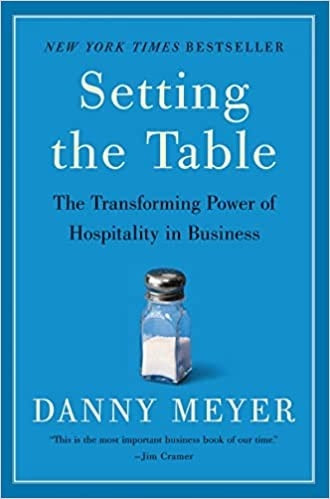How To Fire A Customer
Oct 08, 2022
October 8, 2022
Read time: 3 minutes
This week's edition of the 3-Minute Business Coach teaches the number one skill that we don't teach leaders. How to fire customers.
In 1909, Harry Selfridge adopted the slogan,” the customer is always right,” and used it to give customer satisfaction the highest priority. I used to repeat this phrase often in my career, bending over backward to make sure the customer was always happy because they were the ones providing for the business by increasing our revenue.
But I came to realize treating the customer well is important it is not everything.
Let's dig in.
We’ll miss you
Nick, we need to talk.”
This was how I was greeted by our director of customer success when he walked into my office that day.
“One of our members just screamed at one of our employees, and now our employee is crying in the bathroom. I don’t have the full story yet, but I thought you would want to know.”
We had just started flying, so we didn’t know what we didn’t know. We were dealing with the consequences of bad decisions left and right, working tirelessly to correct them and dial in the customer service aspect of running an airline. Every day I came into work, I was filled with embarrassment about all the disparaging things I used to say about the legacy airlines I flew almost every week. As it turned out, running an airline isn’t easy, and it certainly isn’t for the faint of heart.
Of course, customer satisfaction was a big deal to us in those days! It had to be if we wanted to keep going and growing. But as I sat in my office that day thinking about my employee crying in the bathroom, I remembered our purpose statement: “RISE exists to take care of its employees.” If I truly wanted to optimize this business, I had to stay true to that purpose, both in theory and in practice.
I called the crying employee and asked her to come to my office. When she entered, she had stopped crying, but the red around her eyes and disheveled eyeliner betrayed her best attempt to collect herself. I knew this woman well, so I knew she was not easily thrown off or frustrated. If she was in this state, something bad must have happened.
“What happened?” I asked.
“It’s really not that big of a deal. One of our members was upset at a delayed plane, and I think he was just having a bad day,” she said quietly.
“Who was the member?” I asked.
She responded with the name, and now it was my turn to take a deep breath. The member in question was not our most famous member, but he held his own in most areas of his life, as his overwhelming wealth testified. But was his clout worth sacrificing the well-being of our people? Our values, vision, and purpose?
A Good Entrepreneur would say it wasn’t.
Looking directly into my employee’s eyes, I said, “I need to know exactly what he said to you.”
Her eyes widened, and her face went flush. “Everything?” “Everything,” I confirmed.
She stiffened her back and recounted the conversation word for word. His words were vulgar, pathetic, and mostly childish. In short, he was an adult throwing a temper tantrum because he didn’t get what he wanted. Years of indulgence had taught this man that he could raise his voice and throw his weight and wallet around to get what he wanted. I didn’t want that to be true at RISE.
I thanked the employee, asked her to take the rest of the day off to recover, and prepared for the next conversation I needed to have. I closed the door to my office and dialed the number of this high-powered executive, trying not to think of the revenue we were about to lose as I broke up with this valuable customer. I let out a sigh of relief when I got his voicemail. At least he wouldn’t be able to argue with me.
“Hi, this is Nick Kennedy, the CEO of RISE. I understand that you were upset with a recent interaction with our company, and I’m terribly sorry for the inconvenience that our issue caused you. With that said, I just had a conversation with my employee whom you spoke to, and she told me, in detail, what you said to her. Now I don’t pretend to know what would cause you to be so mean to anyone—much less a woman your daughter’s age who was trying to help you. That type of behavior is not allowed at RISE. We appreciate your business with us, but I am canceling your membership effective today and refunding your money. I wish you the best of luck in the future.”
I hung up the phone, took a deep breath, called my controller, and asked her to refund the money that we so desperately needed. Was losing that money going to help us optimize the business? Not on paper. But in the long run, it would because it meant that we didn’t sacrifice our people or their value along the way.
A few long minutes later, my phone rang. It was the member returning my call.
“This is Nick,” I answered.
Before I could get another word out, the boisterous voice of this now-former member cut in.
“Nick, I loved your service so much. I didn’t know how I could love it anymore, but the fact that you stood up to me being a bully on behalf of your employee makes me love it even more. It’s been years since someone called me out like that, but man, you are so right. I am in the wrong. Can I please stay on as a member? I am so sorry.”
I was dumbfounded. If you had given me a hundred options of how this guy would’ve responded, this would have been number 99 on the list. I quickly thought back to our values. The first one was love. I truly believe you can’t love someone until you know them, so I wanted to create the opportunity for this member to do just that. To see my employee as a person, not just someone who served him. To know that employee so he could treat them with value going forward.
“You didn’t offend me,” I responded, “you offended my employee. She is the one who needs the apology here.”
“If I do that, can I continue to fly?” he pleaded.
“That’s really up to her. Let me speak to her and see if she is willing to talk to you after the way you spoke to her today.”
With that, we ended our call.
I quickly called our employee and explained the situation.
“You’re leaving it up to me to decide if he can come back?” she asked, confused.
“Yes,” I told her confidently. “The offense was toward you, not me.
Therefore, you have total control over the situation. You don’t have to speak with him, but I think it would be good for you to do so.”
Within a few short hours, the power dynamic had flipped. Now, this fresh-out-of-college woman held the power over the seasoned executive.
“Sure, it’s okay for him to call me,” she replied.
And he did. He apologized profusely, and she gave him grace, allowing him to become a member once again. In fact, he went on to become one of our best members.
I wish I had the insight to think about these types of situations when we developed our values, vision, and purpose, but the truth is I didn’t know what was ahead. But what I did know was what it felt like to be on the receiving end of so many abusive employers. I knew how it felt to deal with unethical, unkind, and immature bosses. And I knew that, in the end, that wasn’t the way to optimize your business or your people. So, I made a commitment to the people I had the privilege of leading to be a different kind of leader. I had a set of principles that I could filter these types of situations through to determine the best response—the response that valued people over profit.
And this principle doesn’t just extend to others. It applies to you, the leader, as well.
Homework
If you find yourself thinking through how to prioritize for your organization, think of it in the context of the funnel you see below.
Start at the top and think through each area of this funnel. Rather than just reading each item, write down these items for your organization. Don’t worry if you don’t have the definition of each section of the funnel. Use that blank as an opportunity to clarify your message for your organization. If you are not clear in each area, how can you expect your employees how to handle any given situation?

Mission: Why does your organization exist?
Vision: An emotionally engaging statement that paints the future picture of the organization’s impact.
Values: The compasses for the organization’s decisionmaking and direction. (Should be between 3–7 items)
Culture: What you do is who you are.
Goals: Yardsticks to metricize the organization’s performance
should; be stretched but based on a resourced and achievable reality.
Strategic Plan: The path for reaching the goals.
(Should be incremental (monthly, quarterly, and 1–3–5 years), and each major aspect will require a champion to drive it. There should be an annual offsite retreat to initially create the strat plan, with quarterly reviews.)
Tactics: The operations that drive the strategy.
(Just as a quarterback chooses tactics from his field position, those tactics move the coach’s overall strategy toward the goal. Examples: marketing plans, sales initiatives, culture-building events. One of the most significant challenges in organizations is the tendency to think tactics are the strategy. This creates an ADD-like chaotic atmosphere. A tactic must serve the strategy, or it must be shelved until the strategy changes.)
Vital Behaviors: Specific high-value actions that drive the tactics
(For example, outbound phone calls, accounting behaviors, people taking the initiative to reach out to each other.)
When you are clear on every area of this funnel, suddenly big and small decisions become easy to make. Including when it is okay to fire a customer.
Resources
- Danny Meyer, one of the most influential restaurateurs in modern dining, and lucky for us he wrote a book about how to build an empire and a legacy. Check out Setting The Table by Danny Meyer if you are looking for some inspiration for your own business.

Join Over 300 Leaders!
The 3 Minute Business Coaching Newsletter
Every Friday, I share 1 actionable tip to help you move from being a good leader to a great leader.
(And you can read it in under 3 minutes!)
We hate SPAM. We will never sell your information, for any reason.

